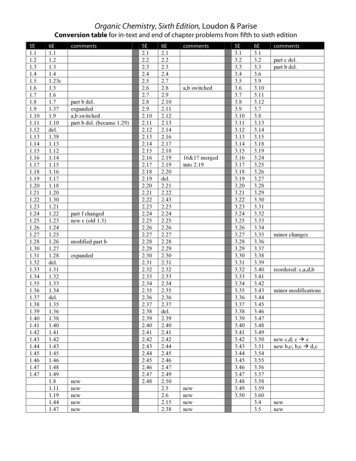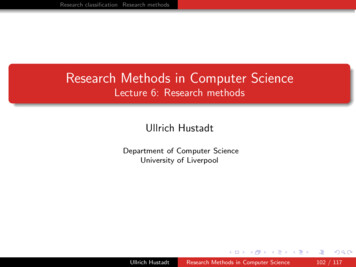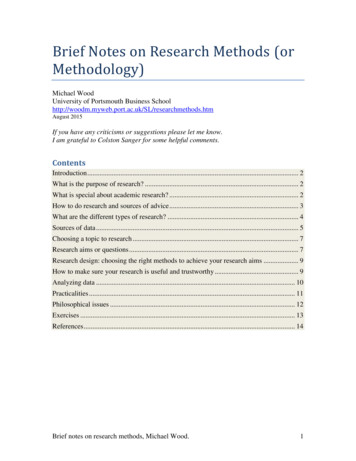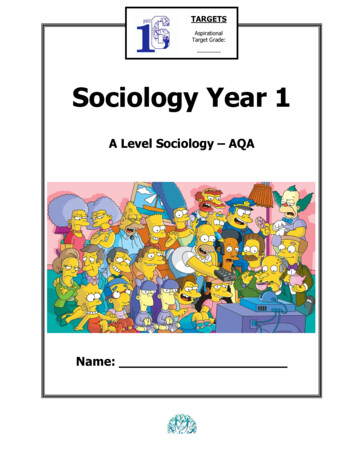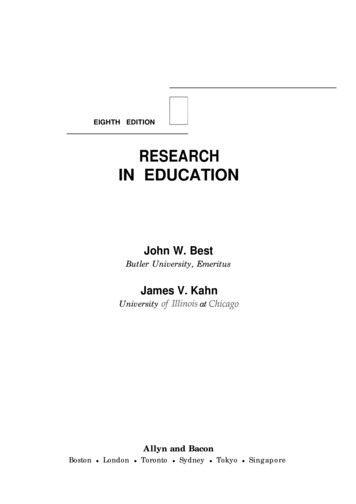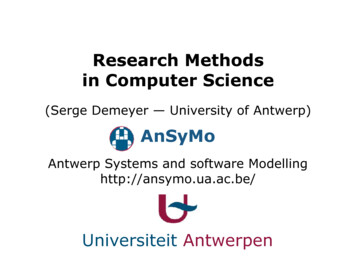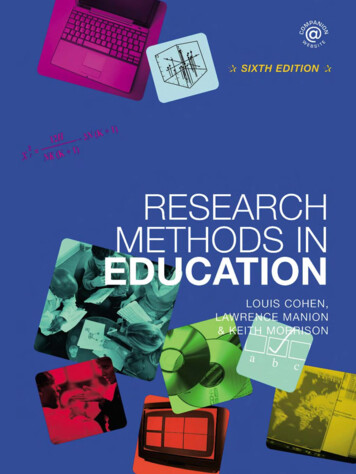
Transcription
Research Methods inEducationThis rewritten and updated sixth edition of the long-running bestseller Research Methods in Educationcovers the whole range of methods currently employed by educational research at all stages. It has fivemain parts: the context of educational research, planning educational research, styles of educationalresearch, strategies for data collection and researching and data analysis. The book contains referencesto a comprehensive dedicated web site of accompanying materials. It continues to be the standard textfor students and lecturers undertaking, understanding and using educational research.This sixth edition comprises new material including:OOOOcomplexity theory, ethics, sampling, sensitive educational research, researching powerful people,Internet-based research, interviewing and surveysexpanded coverage of, and practical guidance in, experimental research, questionnaire design andadministrationan entirely new part, containing five new chapters covering qualitative and quantitative data analysisincluding content analysis, grounded theory, statistics and how to use them, effect size, and reportingdata, all with practical examplesdetailed cross-referencing to a major educational resource web site designed specifically to runalongside this book.Research Methods in Education, sixth edition, is essential reading for both the professional researcher andanyone involved in educational research.Louis Cohen is Emeritus Professor of Education at Loughborough University, UK.Lawrence Manion was former Principal Lecturer in Music at Didsbury School of Education, ManchesterMetropolitan University, UK.Keith Morrison is Professor of Education at the Inter-University Institute of Macau and formerly SeniorLecturer in Education at the University of Durham, UK.
Research Methods inEducationSixth editionLouis Cohen, Lawrence Manionand Keith Morrison
First published 2007 by Routledge2 Park Square, Milton Park, Abingdon, Oxon OX14 4RNSimultaneously published in the USA and Canadaby Routledge270 Madison Avenue, New York, NY 10016Routledge is an imprint of the Taylor & Francis Group, an informa business 2007 Louis Cohen, Lawrence Manion and Keith MorrisonThis edition published in the Taylor & Francis e-Library, 2007.“To purchase your own copy of this or any of Taylor & Francis or Routledge’scollection of thousands of eBooks please go to www.eBookstore.tandf.co.uk.”All rights reserved. No part of this book may be reprinted orreproduced or utilised in any form or by any electronic,mechanical, or other means, now known or hereafterinvented, including photocopying and recording, or in anyinformation storage or retrieval system, without permission inwriting from the publishers.British Library Cataloguing in Publication DataA catalogue record for this book is available from the British LibraryLibrary of Congress Cataloging-in-Publication DataA catalog record for this book has been requestedISBN 0-203-02905-4 Master e-book ISBNISBN 10: 0–415–37410–3 (hbk)ISBN 10: 0–415–36878–2 (pbk)ISBN 10: 0–203–02905–4 (ebk)ISBN 13: 978–0–415–37410–1 (hbk)ISBN 13: 978–0–415–36878–0 (pbk)ISBN 13: 978–0–203–02905–3 (ebk)
For Lawrence Manion, a wise counsellor and a good friend
ContentsList of boxesAcknowledgementsIntroductionxiiixvii1Research and evaluationResearch, politics and policy-makingMethods and methodologyPart 1The context of educational research1The nature of inquiry – Setting thefieldIntroduction5The search for truth5Two conceptions of social reality7Positivism9The assumptions and nature ofscience11The tools of science14The scientific method15Criticisms of positivism and the scientificmethod17Alternatives to positivistic social science:naturalistic approaches19A question of terminology: the normativeand interpretive paradigms21Phenomenology, ethnomethodology andsymbolic interactionism22Criticisms of the naturalistic and interpretiveapproaches25Critical theory and critical educationalresearch26Criticisms of approaches from criticaltheory29Critical theory and curriculumresearch30A summary of the three paradigms32The emerging paradigm of complexitytheory33Feminist research34414647Part 2Planning educational research2The ethics of educational and socialresearchIntroduction51Informed consent52Access and acceptance55The field of ethics58Sources of tension58Voices of experience61Ethical dilemmas62Ethics and research methods ineducation69Ethics and evaluative research70Research and regulation: ethical codes andreview71Sponsored research74Responsibilities to the researchcommunity75Conclusion753Planning educational researchIntroductionA framework for planning researchA planning matrix for research787887
viiiCONTENTSManaging the planning of researchA worked exampleConclusion939598Part 3Styles of educational research7Naturalistic and ethnographic research4 SamplingIntroductionThe sample sizeSampling errorThe representativeness of the sampleThe access to the sampleThe sampling strategy to be usedProbability samplesNon-probability samplesPlanning a sampling ements of naturalistic inquiryPlanning naturalistic researchCritical ethnographySome problems with ethnographic andnaturalistic approaches8What is sensitive research?Sampling and accessEthical issues in sensitive researchResearching powerful peopleAsking questionsConclusion1191211241271301316 Validity and reliabilityDefining validityTriangulationEnsuring validityReliability in quantitative researchReliability in qualitative researchValidity and reliability in interviewsValidity and reliability inexperimentsValidity and reliability inquestionnairesValidity and reliability inobservationsValidity and reliability in testsValidity and reliability in lifehistories1331411441461481501559188Historical and documentary researchIntroductionChoice of subjectData collectionEvaluationWriting the research reportThe use of quantitative methodsLife historiesDocumentary research5 Sensitive educational research167171186191192193194195197198201Surveys, longitudinal, cross-sectionaland trend studiesIntroduction205Some preliminary considerations207Planning a survey208Survey sampling211Longitudinal, cross-sectional and trendstudies211Strengths and weaknesses of longitudinal,cohort and cross-sectional studies214Postal, interview and telephonesurveys218Event history analysis22415715815916410 Internet-based research and computerusageIntroductionInternet-based surveysInternet-based experimentsInternet-based interviews226226239241
CONTENTSSearching for research materials on theInternetEvaluating web sitesComputer simulationsGeographical Information Systems14 Action research24224424525111 Case studiesWhat is a case study?Examples of kinds of case studyWhy participant observation?Recording observationsPlanning a case studyWriting up a case fining action researchPrinciples and characteristics of actionresearchAction research as critical praxisProcedures for action researchReflexivity in action researchSome practical and 12Part 4Strategies for data collection andresearching12 Ex post facto researchIntroductionCo-relational and criterion groupsdesignsCharacteristics of ex post factoresearchOccasions when appropriateAdvantages and disadvantages ofex post facto researchDesigning an ex post factoinvestigationProcedures in ex post facto research26426526626826826927013 Experiments, quasi-experiments,single-case research and meta-analysisIntroduction272Designs in educationalexperimentation274True experimental designs275A quasi-experimental design: thenon-equivalent control group design282Single-case research: ABAB design284Procedures in conducting experimentalresearch285Examples from educational research287Evidence-based educational research andmeta-analysis28915 QuestionnairesIntroductionEthical issuesApproaching the planning of aquestionnaireTypes of questionnaire itemsAsking sensitive questionsAvoiding pitfalls in question writingSequencing the questionsQuestionnaires containing few verbalitemsThe layout of the questionnaireCovering letters or sheets and follow-uplettersPiloting the questionnairePractical considerations in questionnairedesignAdministering questionnairesProcessing questionnaire data31731731832133333433633733833934134234434616 InterviewsIntroductionConceptions of the interviewPurposes of the interviewTypes of interview349349351352ix
xCONTENTSPlanning interview-based researchproceduresGroup interviewingInterviewing childrenFocus groupsThe non-directive interview and thefocused interviewTelephone interviewingEthical issues in interviewing35637337437637737938217 AccountsIntroductionThe ethogenic approachCharacteristics of accounts andepisodesProcedures in eliciting, analysing andauthenticating accounts: an exampleNetwork analyses of qualitative dataWhat makes a good network?Discourse analysisAnalysing social episodesAccount gathering in educationalresearch: an exampleProblems in gathering and analysingaccountsStrengths of the ethogenic approachA note on stories38438438438538838838939139139239339418 ObservationIntroductionStructured observationCritical incidentsNaturalistic and participantobservationNatural and artificial settings forobservationEthical considerationsSome cautionary commentsConclusion39639840440440840841041219 TestsIntroductionWhat are we testing?414414Parametric and non-parametric testsNorm-referenced, criterion-referencedand domain-referenced testsCommercially produced tests andresearcher-produced testsConstructing a testDevising a pretest and post-testReliability and validity of testsEthical issues in preparing for testsComputerized adaptive testing41441541641843243243243320 Personal constructsIntroduction435Characteristics of the method435‘Elicited’ versus ‘provided’ constructs436Allotting elements to constructs437Laddering and pyramid constructions439Grid administration and analysis439Procedures in grid administration439Procedures in grid analysis439Strengths of repertory grid technique442Difficulties in the use of repertory gridtechnique442Some examples of the use of repertorygrid in educational research443Grid technique and audio/video lessonrecording445Focused grids, non-verbal grids, exchangegrids and sociogrids44621 Role-playingIntroductionRole-playing versus deception: theargumentRole-playing versus deception: theevidenceRole-playing in educational settingsThe uses of role-playingStrengths and weaknesses of role-playingand other simulation exercisesRole-playing in an educational setting:an exampleEvaluating role-playing and othersimulation exercises448450451452452455455456
CONTENTSPart 5Data analysis22 Approaches to qualitative data analysisIntroductionTabulating dataFive ways of organizing and presentingdata analysisSystematic approaches to dataanalysisMethodological tools for analysingqualitative 3 Content analysis and grounded theoryIntroductionWhat is content analysis?How does content analysis work?A worked example of contentanalysisComputer usage in content analysisReliability in content analysisGrounded theoryInterpretation in qualitative dataanalysis: multilayered textsReliabilityExploratory data analysis: frequencies,percentages and cross-tabulationsStatistical significanceHypothesis testingEffect sizeThe chi-square testDegrees of freedomMeasuring associationRegression analysisMeasures of difference between groupsand means47547547648348749049149525 Multidimensional measurement andfactor analysisIntroductionElementary linkage analysis: anexampleFactor analysisFactor analysis: an exampleExamples of studies usingmultidimensional scaling and clusteranalysisMultidimensional data: some words onnotationMultilevel modellingCluster analysis55955956057057657958358424 Quantitative data analysisIntroductionScales of dataParametric and non-parametric dataDescriptive and inferential statisticsOne-tailed and two-tailed testsDependent and independentvariables50150250350350450426 Choosing a statistical testHow many samples?Assumptions of tests586591NotesBibliographyIndex593599633xi
Boxes1.1 The subjective–objectivedimension91.2 Alternative bases for interpreting socialreality101.3 The functions of science121.4 The hypothesis151.5 Stages in the development ofscience161.6 An eight-stage model of the scientificmethod161.7 A classroom episode201.8 Differing approaches to the study ofbehaviour332.1 The costs/benefits ratio522.2 Guidelines for reasonably informedconsent532.3 Close encounters of a researcherkind562.4 Conditions and guarantees profferedfor a school-based research project572.5 Negotiating access checklist592.6 Absolute ethical principles in socialresearch612.7 An extreme case of deception672.8 Ethical principles for the guidance ofaction researchers702.9 An ethical code: an illustration762.10 Ethical principles for educationalresearch (to be agreed before the researchcommences)773.1 The elements of research design793.2 Elements of research styles843.3 A matrix for planning research883.4 A planning sequence for research943.5 A planning matrix for research953.6 Understanding the levels oforganizational culture964.1 Sample size, confidence levels andconfidence intervals for randomsamples1044.2 Distribution of sample means showingthe spread of a selection of sample meansaround the population mean1075.1 Issues of sampling and access insensitive research1245.2 Ethical issues in sensitive research1275.3 Researching powerful people1305.4 Key questions in considering sensitiveeducational research1326.1 Principal sources of bias in life historyresearch1648.1 Some historical interrelations betweenmen, movements and institutions1928.2 A typology of life histories and theirmodes of presentation1999.1 Stages in the planning of a survey2109.2 Types of developmental research2149.3 Advantages of cohort over crosssectional designs2179.4 The characteristics, strengths andweaknesses of longitudinal,cross-sectional, trend analysis, andretrospective longitudinal studies21910.1 Problems and solutions inInternet-based surveys23110.2 Geographical Information Systems insecondary schools25110.3 Location of home postcodes usingGeographical InformationSystems25211.1 Possible advantages of case study25611.2 Strengths and weaknesses of casestudy25611.3 A typology of observation studies25911.4 The case study and problems ofselection26111.5 Continua of data collection, typesand analysis in case studyresearch262
xivBOXES13.1 Independent and dependentvariables13.2 The effects of randomization13.3 Interaction effects in anexperiment13.4 The ABAB design13.5 An ABAB design in an educationalsetting13.6 Class size and learning in wellcontrolled and poorly controlledstudies14.1 A model of emancipatory actionresearch for organizational change15.1 A flow chart technique for questionplanning15.2 A guide for questionnaireconstruction15.3 A 10-point marking scale in aquestionnaire15.4 Potential problems in conductingresearch15.5 A flow chart for the planning of apostal survey16.1 Attributes of ethnographers asinterviewers16.2 Summary of relative merits ofinterview versus questionnaire16.3 Strengths and weaknesses of differenttypes of interview16.4 The selection of response mode16.5 Guidelines for the conduct ofinterviews16.6 Delineating units of generalmeaning16.7 Units of relevant meaning16.8 Clusters of relevant meaning17.1 Principles in the ethogenicapproach17.2 Account gathering17.3 Experience sampling method17.4 Concepts in children’s talk17.5 ‘Ain’t nobody can talk about thingsbeing about 35035235336036637137137238538638739039217.6 Parents and teachers: divergentviewpoints on children’scommunicative competence39317.7 Justification of objective systematicobservation in classroom settings39418.1 A structured observation schedule39918.2 Non-participant observation:a checklist of design tasks40118.3 Structured, unstructured, natural andartificial settings for observation40919.1 A matrix of test items41919.2 Compiling elements of test items42020.1 Eliciting constructs and constructinga repertory grid43620.2 Allotting elements to constructs:three methods43820.3 Laddering44020.4 Elements44020.5 Difference score for constructs44120.6 Grid matrix44121.1 Dimensions of role-play methods44921.2 The Stanford Prison experiment45021.3 Critical factors in a role-play: smokingand young people45421.4 Categorization of responses to fourvideo extracts45622.1 The effectiveness of Englishteaching46422.2 The strengths and weaknesses ofEnglish language teaching46422.3 Teaching methods46522.4 Student-related factors46624.1 Frequencies and percentages for acourse evaluation50724.2 Cross-tabulation by totals50824.3 Cross-tabulation by row totals50924.4 Rating scale of agreement anddisagreement51024.5 Satisfaction with a course51024.6 Combined categories of ratingscales51024.7 Representing combined categories ofrating scales511
.2724.2824.2924.3024.31How well learners are cared for,guided and supportedStaff voluntarily taking oncoordination rolesDistribution of test scoresA line graph of test scoresDistribution around a mean with anoutlierA platykurtic distribution ofscoresA leptokurtic distribution ofscoresType I and Type II errorsMean and standard deviation in aneffect sizeThe Levene test for equality ofvariancesMean and standard deviation in apaired sample testDifference test for a paired sampleEffect size in analysis of varianceA 2 3 contingency table forchi-squareA 2 5 contingency table forchi-squareCommon measures of relationshipPercentage of public library membersby their social class originCorrelation scatterplotsA Pearson product-momentcorrelationA line diagram to indicatecurvilinearityVisualization of correlation of 0.65between reading grade and arithmeticgradeA scatterplot with the regressionlineA scatterplot with grid lines andregression lineA summary of the R, R square andadjusted R square in 352452452652752952953253353353553753853824.32 Significance level in regressionanalysis53924.33 The beta coefficient in a regressionanalysis53924.34 A summary of the R, R square andadjusted R square in multipleregression analysis54024.35 Significance level in multipleregression analysis54124.36 The beta coefficients in a multipleregression analysis54124.37 Means and standard deviations for at-test54424.38 The Levene test for equality ofvariances in a t-test54424.39 A t-test for leaders and teachers54524.40 The Levene test for equality ofvariances between leaders andteachers54524.41 Means and standard deviations in apaired samples t-test54624.42 The paired samples t-test54724.43 Descriptive statistics for analysis ofvariance54824.44 SPSS output for one-way analysis ofvariance54824.45 The Tukey test54924.46 Homogeneous groupings in the Tukeytest54924.47 Means and standard deviations in atwo-way analysis of variance55124.48 The Levene test of equality ofvariances in a two-way analysis ofvariance55124.49 Between-subject effects in two-wayanalysis of variance55224.50 Graphic plots of two sets of scores ona dependent variable55224.51 A cross-tabulation for aMann-Whitney U test55324.52 SPSS output on rankings for theMann-Whitney U test55324.53 The Mann-Whitney U value andsignificance level in SPSS553xv
xviBOXES24.54 Frequencies and percentages ofvariable one in a Wilcoxon test55424.55 Frequencies and percentages ofvariable two in a Wilcoxon test55424.56 Ranks and sums of ranks in aWilcoxon test55524.57 Significance level in a Wilcoxontest55524.58 Cross-tabulation for theKruskal-Wallis test55624.59 Rankings for the Kruskal-Wallistest55624.60 Significance levels in a Kruskal-Wallistest55624.61 Frequencies for variable one in theFriedman test55724.62 Frequencies for variable two in theFriedman test55724.63 Frequencies for variable three in theFriedman test55824.64 Rankings for the Friedman test55824.65 Significance level in the Friedmantest55825.1 Rank ordering of ten children onseven constructs56125.2 Intercorrelations between sevenpersonal constructs56225.3 The structuring of relationshipsamong the seven personalconstructs56325.4 Initial SPSS output for principalcomponents analysis56425.5 A scree plot56525.6 Three-dimensional rotation56625.7 The rotated components matrix inprincipal components analysis56725.8 Factor analysis of responsibility forstress items57125.9 Factor analysis of the occupationalstress items57325.10 Factor analysis of the occupationalsatisfaction items25.11 Correlations between (dependent)stress and (independent) satisfactionfactors and canonical variates25.12 Biographical data and stressfactors25.13 Students’ perceptions of socialepisodes25.14 Perception of social episodes25.15 Person concept coding system25.16 Reliability coefficients for peerdescriptions25.17 Sex, voting preference and socialclass: a three-way classificationtable25.18 Sex, voting preference and socialclass: a three-way notationalclassification25.19 Expected frequencies in sex, votingpreference and social class25.20 Expected frequencies assuming thatsex is independent of social class andvoting preference25.21 Sex and voting preference: a two-wayclassification table25.22 Cluster analysis26.1 Identifying statistical tests for anexperiment26.2 Statistical tests to be used withdifferent numbers of groups ofsamples26.3 Types of statistical tests for four scalesof data26.4 Choosing statistical tests forparametric and non-parametricdata26.5 Statistics available for different typesof data26.6 Assumptions of statistical 588589590592
AcknowledgementsOur thanks are due to the following publishers and authors for permission to include materials in thetext:Allyn & Bacon/Pearson Education, for material fromBest, J. W. (1970) Research in Education.Blackwell Publishers, for material from Dyer, C.(1995) Beginning Research in Psychology;Robson, C. (1993) Real World Research;Robson, C. (2002) Real World Research (secondedition).British Psychological Society, for material fromAdams-Webber, J. R. (1970) Elicited versusprovided constructs in repertory grid technique:a review, British Journal of Medical Psychology,43, 349–54. Reproduced with permission fromthe British Journal of Medical Psychology TheBritish Psychological Society.Campbell, D. T. and Stanley, J. C. Experimentaland Quasi-Experimental Designs for Research.Copyright 1963 by Houghton MifflinCompany.Continuum Books, for material from Walford, G.(2001) Doing Qualitative Educational Research,pp. 30, 31, 36, 137.Deakin University Press, Deakin, Australia, for wordsfrom Kemmis, S. and McTaggart, R. (1981)The Action Research Planner, and Kemmis, S.and McTaggart, R. (1992) The Action ResearchPlanner (third edition) 8 and 21–8.Elsevier, for material reprinted from InternationalJournal of Educational Research, vol. 18(3),Edwards, D. Concepts, memory and the organisation of pedagogic discourse, pp. 205–25,copyright 1993, with permission from Elsevier; Social Method and Social Life, M. Brenner(ed.), article by J. Brown and J. Sime: Amethodology for accounts, p. 163, copyright 1981, with permission from Elsevier.Hughes, J. (1976), for material from SociologicalAnalysis: Methods of Discovery, Nelson Thornes,p. 34.Lawrence Erlbaum Associates, for material fromMurphy, J., John, M. and Brown, H.(eds) (1984) Dialogues and Debates inSocial Psychology. London: Lawrence ErlbaumAssociates.McAleese, R. and Hamilton, D. (eds) (1978)Understanding Classroom Life. Slough: NationalFoundation for Educational Research.Multilingual Matters Ltd, Clevedon, for figures fromParsons, E., Chalkley, B. and Jones, A. (1996)The role of Geographic Information Systems inthe study of parental choice and secondaryschool catchments, Evaluation and Researchin Education, 10(1), 23–34; for words fromStronach, I. and Morris, B (1994) Polemicalnotes on educational evaluation in an ageof ‘policy hysteria’, Evaluation and Research inEducation, 8(1), 5–19.Patton, M. Q. (1980) Qualitative Evaluation Methods, p. 206, copyright Sage Publications Inc.,reprinted by permission of Sage PublicationsInc.Pearson Education Ltd, for material from Harris, N.,Pearce, P. and Johnstone, S. (1992) The LegalContext of Teaching.Penguin Group UK, for material from Armistead, N. (1974) Reconstructing Social Psychology.Prentice-Hall, for material from Garfinkel, H.(1974) Studies in Ethnomethodology; Smith,R. W. (1978) Strategies in Social Research.Princeton University Press, for material fromKierkegaard, S. (1974) Concluding UnscientificPostscript.Reips, U.-D. (2002a) Internet-based psychologicalexperimenting: five dos and don’ts. Social Science Computer Review, 20(3), 241–9; (2002b)Standards for Internet-based experimenting.Experimental Psychology, 49(4), 243–56.
xviiiACKNOWLEDGEMENTSSpringer, for Hycner, R. H. (1985) Some guidelinesfor the phenomenological analysis of interviewdata, Human Studies, 8, 279–303, with kindpermission of Springer Science and BusinessMedia.Stanford University Press, for material fromSears, R., Maccoby, E. and Levin, H. (1976)Patterns of Child Rearing (originally published1957).Taylor & Francis, for Brenner, M. and Marsh, P.(eds) (1978) The Social Contexts of Method;Burgess, R. (ed.) (1993) Educational Researchfor Policy and Practice, pp. 119 and 135;Burgess, R. (ed.) (1985) Issues in EducationalResearch, pp. 116–28 and 244–7; Burgess, R.(ed.) (1989) The Ethics of Educational Research,p. 194; Cuff, E. G. and Payne, G. (1979)Perspectives in Sociology, p. 4; Hammersley, M.and Atkinson, P. (1983) Ethnography: Principlesand Practice, pp. 18, 19, 76; Hitchcock, G.and Hughes, D. (1995) Research and theTeacher (second edition), pp. 20–2, 41;Kincheloe, J. (2003) Teachers as Researchers:Qualitative Inquiry as a Path to Empowerment(second edition), pp. 138–9; McCormick, J.and Solman, R. (1992) Teachers’ attributionsof responsibility for occupational stress andsatisfaction: an organisational perspective,Educational Studies, 18(92), 201–22; McNiff, J.(2002) Action Research: Principles and Practice(second edition), pp. 85–91; Medawar, P.(1972) The Hope of Progress; Oldroyd, G. (1986)The Arch of Knowledge: An Introductory Study ofthe History of the Philosophy and Methodology ofScience; Plummer, K. (1983) Documents of Life:An Introduction to the Problems and Literature ofa Humanistic Method; Rex, J. (1974) Approachesto Sociology; Simons, H. and Usher, R. (2000)Situated Ethics in Educational Research, pp. 1–2;Walford, G. (1994) Researching the Powerfulin Education; Zuber-Skerritt, O. (1996) NewDirections in Action Research, p. 99; Winter, R.(1982) Dilemma analysis: a contribution tomethodology for action research, CambridgeJournal of Education, 12(3), 161–74.University of Chicago Press, for brief quotationsfrom Whyte, W. F. (1993) Street Corner Society,pp. 292, 301, 303; Merton, K. and Kendall,P. L. (1946) The focused interview. AmericanJournal of Sociology, 51, 541–57.
IntroductionIt is seven years since the fifth edition of ResearchMethods in Education was published and we areindebted to Routledge for the opportunity toproduce a sixth edition. The book continues tobe received very favourably worldwide and isthe standard text for many courses in researchmethods.The sixth edition contains much new material,including a completely new part on data analysis.This means that the book now covers all stages ofeducational research, from planning and design,through data collection to data analysis andreporting. While retaining the best features ofthe former edition, the reshaping, updating andnew additions undertaken for this new volumenow mean that the book covers a greater spreadof issues than the previous editions. In particular,the following new material has been included:Part One:OOfeminist theorycomplexity theory and educational research.Part Two:OOOOethical codes and responsibilities to sponsorsand the research communityinformed consent and deceptionsampling, confidence levels and confidenceintervals, together with the calculation ofsample sizesan entirely new chapter on planning andconducting sensitive educational research,including researching powerful people.Part Three:OOOfurther coverage of documentary researchpostal, interview and telephone surveysan entirely new chapter on Internet-basedresearch and computer usage, covering Internetsurveys, experiments, interviews, questionnairedesign, evaluation of web sites, searchingOfor materials, computer simulations andGeographical Information Systemsvery considerably expanded coverage of experimental research, reflecting the resurgenceof interest in this method in evidence-basededucation.Part Four:OOmore detailed coverage of questionnaire designand administration, with practical guidance onthese mattersinterviewing children and telephone interviewing.Part Five:OOOOOOOOOOOOOan entirely new part, containing five newchapters, covering qualitative and quantitativedata analysishow to conduct a content analysisgrounded theory and ‘how to do it’how to present and report qualitative datacomputer usage in qualitative data analysisan introduction to statistics and statisticalconceptshypotheses and how to test themvariables and how to handle themeffect size and how to calculate and interpret itpractical ‘hands on’ advice for noviceresearchers, on which statistics to choose andhow to use them, from the simplest statisticsto high-level factor analysis and multipleregression, and from descriptive to inferentialstatisticsadvice on how to select appropriate statistics,with charts and diagrams to ease selectionhow to avoid selecting incorrect statistics, andwhat are the assumptions underlying the mainkinds of statisticsplentiful examples of statistics and how tointerpret them, with worked examples that useSPSS output and processing (the S
Research Methods in Education This rewritten and updated sixth edition of the long-running bestseller Research Methods in Education covers the whole range of methods currently employed by educational research at all stages. It has five main parts: the context of educational resea



